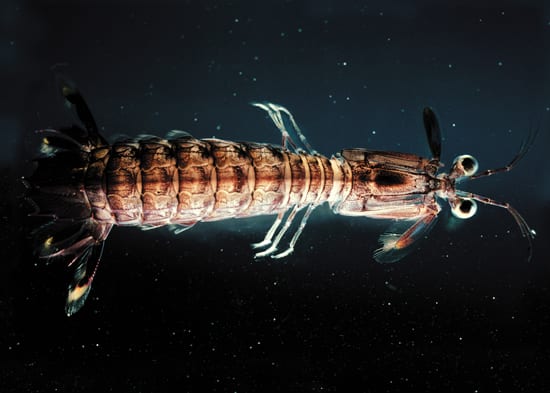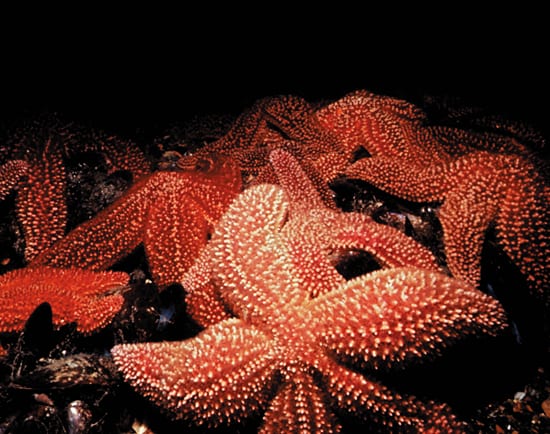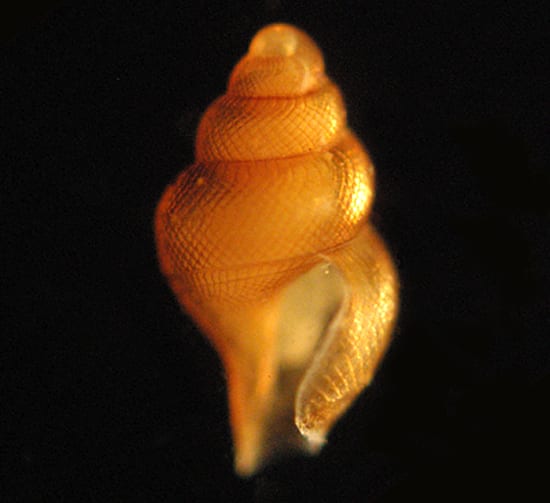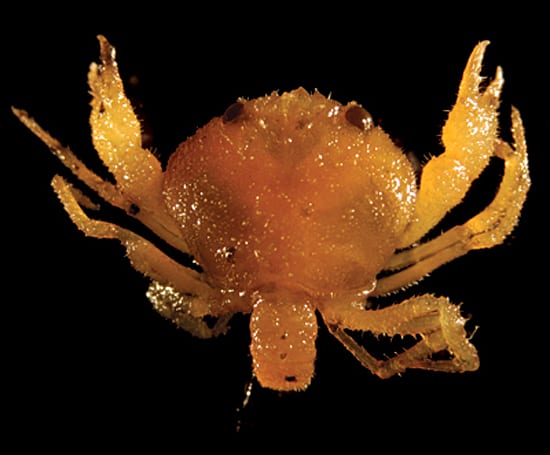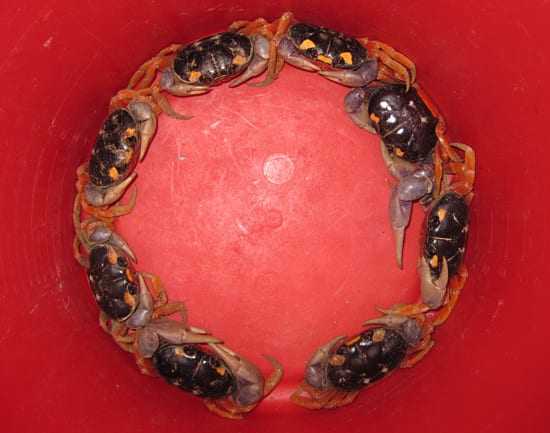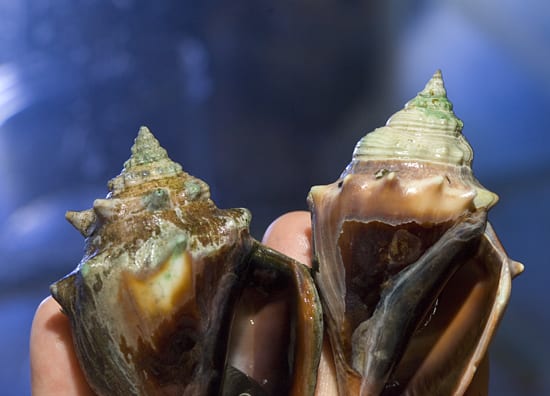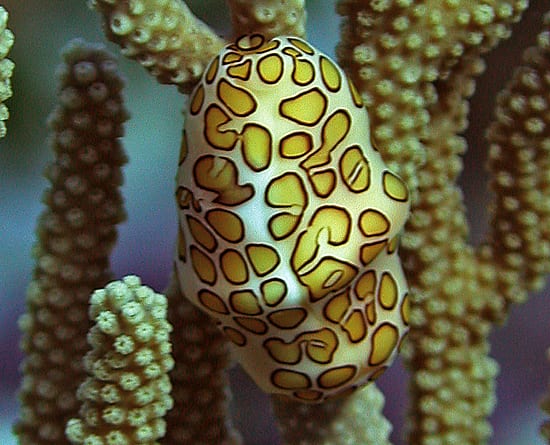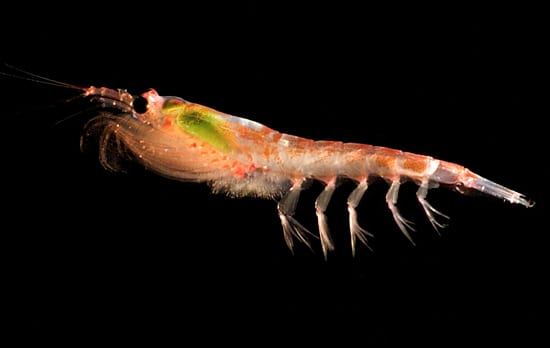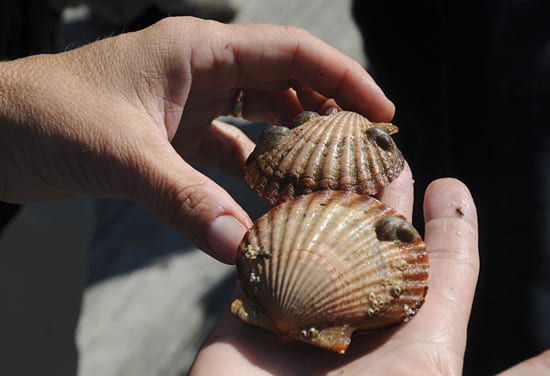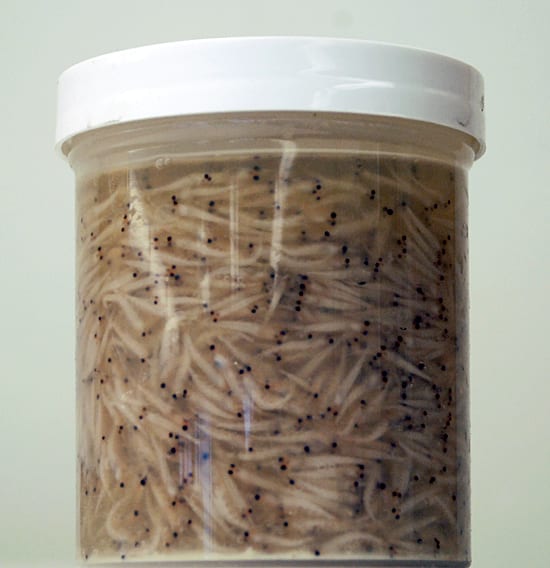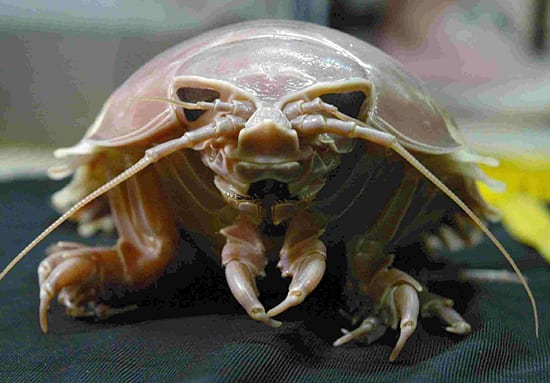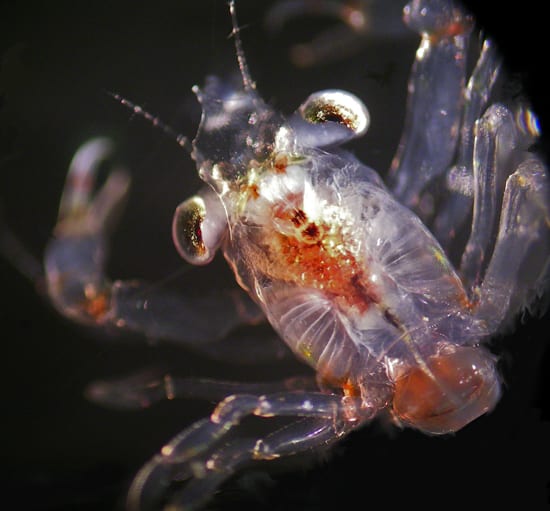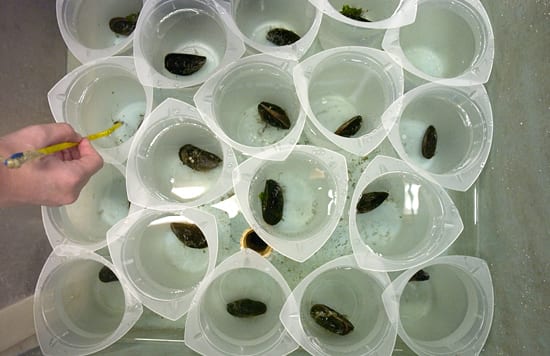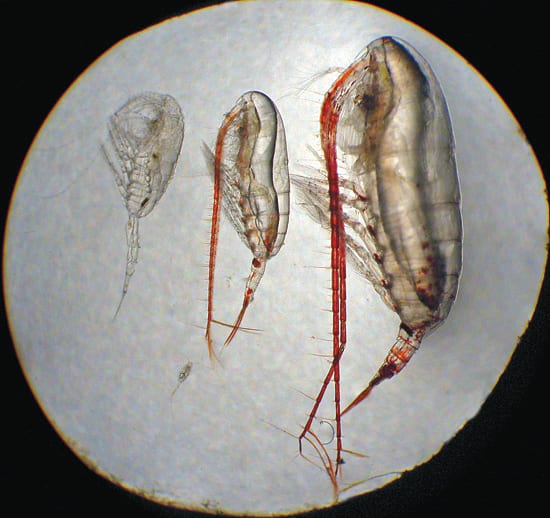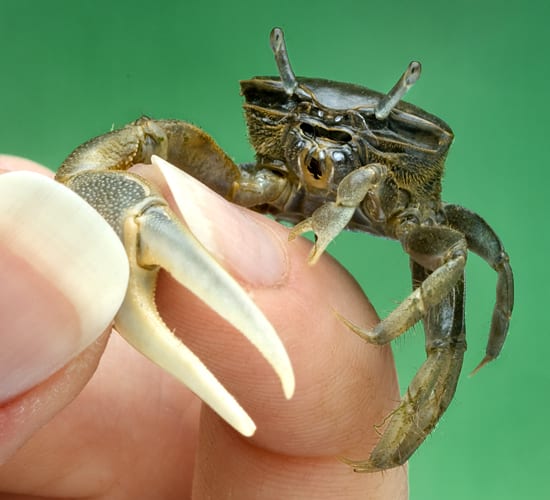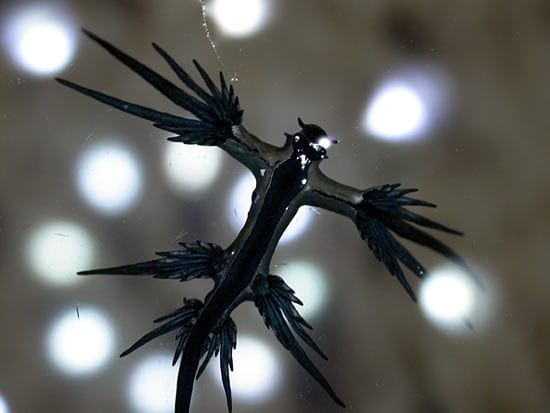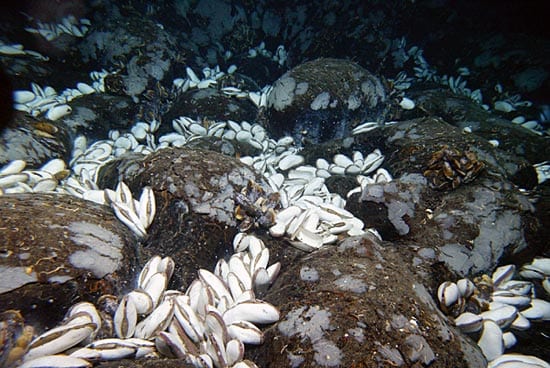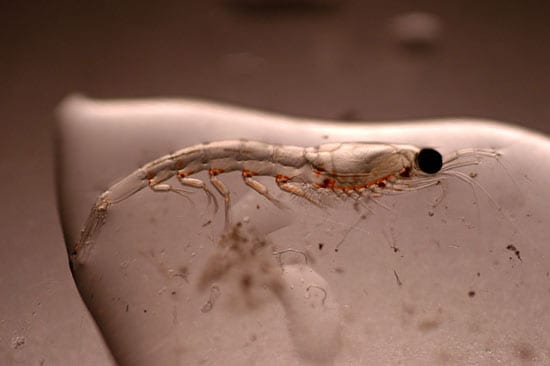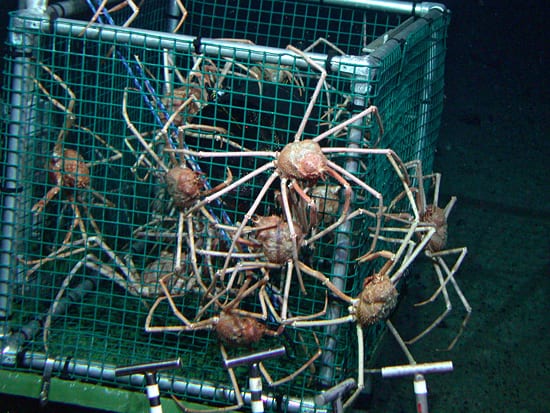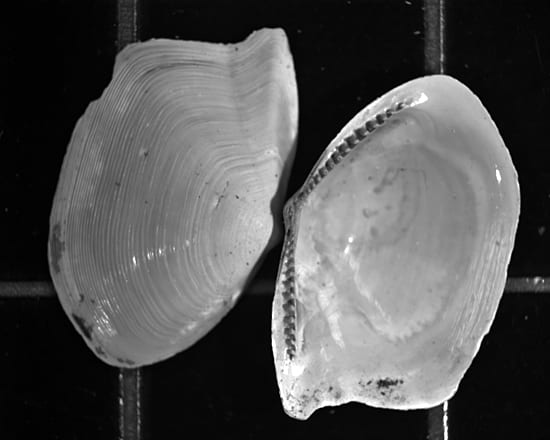 In sediments beneath the Sargasso Sea, WHOI geologist Lloyd Keigwin found a 17,500-year-old clamshell and a mystery: Why was this South Atlantic species living in deep water near Bermuda at that time? In fact, previous research has shown that water from the Southern Ocean water once flowed into the North Atlantic. This suggests the Atlantic’s heat-distributing “conveyor belt” had slowed or stopped, chilling northern climates and allowing deep water from the far south flow into the deep North Atlantic, carrying with it, among other things, clam larvae. (Photo by Lloyd Keigwin, Woods Hole Oceanographic Institution)
In sediments beneath the Sargasso Sea, WHOI geologist Lloyd Keigwin found a 17,500-year-old clamshell and a mystery: Why was this South Atlantic species living in deep water near Bermuda at that time? In fact, previous research has shown that water from the Southern Ocean water once flowed into the North Atlantic. This suggests the Atlantic’s heat-distributing “conveyor belt” had slowed or stopped, chilling northern climates and allowing deep water from the far south flow into the deep North Atlantic, carrying with it, among other things, clam larvae. (Photo by Lloyd Keigwin, Woods Hole Oceanographic Institution)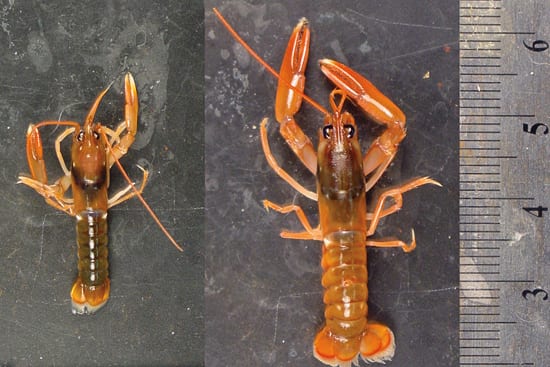 Post-doc Justin Ries—now at UNC—along with WHOI scientists Anne Cohen and Dan McCorkle grew shell-building ocean animals in water under air containing different levels of carbon dioxide, a greenhouse gas that makes seawater more acidic and corrosive to calcium carbonate shells. In a surprising finding, American lobsters and some other crustaceans grown under very high carbon dioxide (at right) grew larger, heavier shells than lobsters (left) grown under levels found in today’s atmosphere. Shells of other organisms, however, were damaged by the higher acidity. (Photo by Justin Ries, Woods Hole Oceanographic Institution)
Post-doc Justin Ries—now at UNC—along with WHOI scientists Anne Cohen and Dan McCorkle grew shell-building ocean animals in water under air containing different levels of carbon dioxide, a greenhouse gas that makes seawater more acidic and corrosive to calcium carbonate shells. In a surprising finding, American lobsters and some other crustaceans grown under very high carbon dioxide (at right) grew larger, heavier shells than lobsters (left) grown under levels found in today’s atmosphere. Shells of other organisms, however, were damaged by the higher acidity. (Photo by Justin Ries, Woods Hole Oceanographic Institution)- Scientists collected this 2.5-inch juvenile stomatopod, or "snapping shrimp," in a plankton net in the Arabian Sea. Adult stomatopods live on coral reefs, where big eyes and good color vision aid in their survival and ability to thrive. Two of the many reasons WHOI scientists study coral reef environments are for clues to past climate and information about how reef-dwelling fish populations survive and reproduce. (Photo by Larry Madin, Woods Hole Oceanographic Institution)
- A constellation of starfish congregates under the WHOI Pier in the late 1980s. Blue mussels, a favorite food of starfish, sometimes settle and grow in huge colonies on the pier. When the mussels grow large enough, clumps of them fall to the bottom—attracting starfish, which make short work of the bounty. According to Terry Rioux, who oversaw the WHOI diving program for 30 years and often dove under the pier, the mussels were abundant for a few years, then scarce, then abundant again. (Photo by Terry Rioux, Woods Hole Oceanographic Institution)
- This tiny (1mm) larval snail with a swirled, sculpted shell was collected in 2005 from a hydrothermal vent site 2500 meters deep, where adults of its species reach 7 cm. The ChEss (Biogeography of Deep-Water Chemosynthetic Ecosystems) research project, co-chaired by WHOI scientistChris German, aims to understand the distribution of vent species, and enabled WHOI researchers Susan Mills and Stace Beaulieu to create and print a guide to vent larvae. ChEss is part of the Census of Marine Life (CoML), a ten-year global program initiated by the Alfred P. Sloan Foundation trying to answer the question, “What lives in the sea?” The final CoML report was released October 4, 2010. (Image courtesy of Stace Beaulieu, Woods Hole Oceanographic Institution)
- Scientists collected this 8mm crab larva at a deep-sea hydrothermal vent site where an eruption of lava had recently covered the site. Adults of this species (Bythograea thermydron) were common before and after the eruption, but their planktonic larvae were more abundant afterwards. This image is from a guide to larvae at hydrothermal vents, created by WHOI researchers Susan Mills and Stace Beaulieu with funding from the National Science Foundation, the WHOI Deep Ocean Exploration Institute, and the Biogeography of Deep-water Chemosynthetic Ecosystems (ChEss) project of the Census of Marine Life. (Image by Susan Mills, Woods Hole Oceanographic Institution)
- Square land crabs (Gecarcinus quadratus) form a defensive ring in a collection bucket at the Liquid Jungle Lab in Panama. Research by Joanna Gyory, a graduate student in the MIT/WHOI Joint Program in Oceanography, revealed the previously unknown life cycle and behavior of the crabs, which live on land but emerge from their burrows at the first sign of rainy season and swarm nearby beaches to lay their eggs in the ocean. This photo also graces the cover of the newest issue of Oceanus magazine, which features an article on Gyory and her crabs. (Photo by Joanna Gyory, Woods Hole Oceanographic Institution)
- Justin Ries, a former postdoctoral scholar at WHOI, and colleagues Anne Cohen and Dan McCorkle grew 18 species of shell-building marine organisms in tanks under air containing different concentrations of carbon dioxide—from the level in today's atmosphere, to higher levels predicted for the future, to extremely high levels. Not all species responded the same way to higher carbon dioxide levels in seawater and the higher aciditiy it generates. Some species, such as conchs (Strombus alatus), deteriorated, but surprisingly, some thrived. Learn more about the research in Oceanus magazine (Photo by Tom Kleindinst, Woods Hole Oceanographic Institution)
- A Flamingo Tongue snail crawls over soft corals in the Caribbean. In an "arms race" over evolutionary time, the corals developed toxins that deter predators, but the snail evolved a group of genes and proteins called a "defensome" that detoxify coral compounds and allow it to eat the corals. This work, by student Kristen Whalen in biologist Mark Hahn's lab is included in a recent issue of Oceanus magazine featuring MIT/WHOI Joint Program students. (Photo by Kristen Whalen, Woods Hole Oceanographic Institution)
- WHOI/MIT Joint Program graduate student Andrew McDonnell captured this image of an Antarctic krill during the first of two month-long cruises off of the West Antarctic Peninsula during the Austral Summer of 2009. WHOI Senior Scientist Ken Buesseler and McDonnell are on the cruise to study the ocean's biological pump in which phytoplankton, microbes, and zooplankton create and control the flux of sinking particulate matter from the surface waters and into the deep. The project, funded in part by the Access to the Sea Program and the Coastal Ocean Institute, utilizes a variety of techniques to probe the workings of these processes, including a video plankton recorder to snap thousands of underwater images, which are analyzed onboard the ship to quantify and identify the distributions of particles throughout the water column. (Photo by Andrew McDonnell, Woods Hole Oceanographic Institution)
Ocean acidification—a consequence of increased carbon dioxide emissions from human industrial activity—could harm a wide range of marine organisms and the food webs that depend on them. Mollusks, including oysters, clams and scallops, which support valuable marine fisheries, are particularly sensitive to changes in seawater pH. Ocean acidification could cause U.S. shellfish revenues to drop significantly in the next 50 years, according to a study by WHOI scientists Sarah Cooley and Scott Doney.
(Photo by Erin Koenig, Woods Hole Oceanographic Institution)Krill are very small crustaceans of the sea that eat even smaller creatures called phytoplankton. Krill play a major role in the food chain because they provide food for a huge number of larger animals. From Antarctica to the Arctic, many animals — baleen whales, manta rays, whale sharks, many species of seals, fish, and seabirds — depend on krill as one of their main food sources. A team of researchers spent 38 days in the Arctic to learn about the ecosystem there and the possible effects of climate change.
(Photo courtesy of Carin Ashjian, Woods Hole Oceanographic Institution)- An isopod (Bathynomus giganteus) from the floor of the Gulf of Mexico was caught and carried to the deck of the research vessel Atlantis in the science basket of the Alvin submersible, following a dive in May 2006. "Chuck Fisher (Penn State University) told me that if I died in the sea, this guy's relatives would finish off the leftovers on my way to the seafloor," joked Anton Zafereo, an electronics technician in the Alvin group. "We were more concerned that it wasn't really dead, and it would escape in the night to gorge itself on human brains." (Photo by Anton Zafereo, Woods Hole Oceanographic Institution)
- This juvenile crab was hitching a ride inside the barrel-shaped body of a transparent, gelatinous pelagic tunicate collected at the Liquid Jungle Lab in Panama. Pelagic tunicates, or salps, are the subject of Joint Program Student Kelly Rakow Sutherland's thesis work in the lab of Larry Madin. In the open ocean, crustacean hitchhikers are frequently associated with salps and other jellies. (Photo by Kelly Rakow Sutherland, Woods Hole Oceanographic Institution)
- In a WHOI biology lab, graduate student Diane Poehls Adams is breeding blue mussels, Mytilus edulis,from larvae to mature adults. These mussels experience differentgenetic selection pressures—leading them to express different genes andtraits—depending on whether they are in the ocean or anestuary. This selection could serve to reduce gene flow between the twohabitat types and reduce the population size.Poehls Adams isculturing mussels in the lab, studying their genetic makeup, andtransferring them into the ocean to see which are more successful indifferent marine environments. Understanding the connectivity betweenbottom-dwelling (or "benthic") marine populations isnecessary to properly manage our marine resources. (Photo by Tom Kleindinst, Woods Hole Oceanographic Institution)
- The four major species of copepods in the Beaufort Sea all have different sizes, different life cycles, and different prey. L to R: Metridia longa (~2.5 millimeters), Calanus glacialis (~4mm), Calanus hyperboreus (~7mm). The smallest, Oithona similis (0.5mm) is below the center. The largest species, Calanus hyperboreus, is a critical link in the Arctic food web, eating phytoplankton and microzooplankton when the returning spring light triggers their growth. They are eaten in turn by many larger animals. (Photo by Carin Ashjian, Woods Hole Oceanographic Institution)
- For decades, marine chemists and ecologists have been wondering: does the oil that was spilled into a Cape Cod salt marsh in 1969 still have an impact on the wildlife living in the marsh? Tiny fiddler crabs recently helped provide an answer. (Photo by Tom Kleindinst, Woods Hole Oceanographic Institution)
- The mollusk Glaucus atlanticus, about the size of a quarter, was photographed in a WHOI lab after its capture off the coast of Panama in March. The mollusk hangs upside down from the surface of the water and drifts throughout the tropical oceans, maintaining buoyancy by swallowing air bubbles. (Photo by Jesús Pineda, Woods Hole Oceanographic Institution)
- Giant clams up to one foot long thrive in the crevices around seafloor pillow lava. This vent site on the Galápagos Rift, discovered in 2002, is called "Calyfield" after the clam Calyptogena magnifica. (Photo by Tim Shank, Woods Hole Oceanographic Institution)
- Tiny species like this Euphausid photographed in a drop of water are prey to larger organisms in the oceanic food chain. About the size of a fingernail, the shrimp-like creature was collected in Barrow Canyon in the Arctic Ocean. (Photo by Chris Linder, Woods Hole Oceanographic Institution)
- Crabs cover the sample basket on the front of DSV Alvin during 2002 dives near Patton Seamount in the Gulf of Alaska. (Photo by Woods Hole Oceanographic Institution)
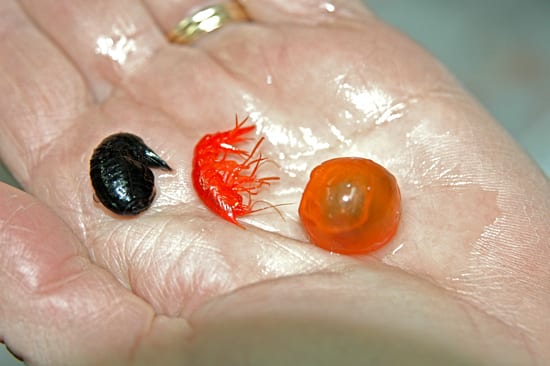 A researcher holds three deep-sea crustaceans collected by MOCNESS, a net and environmental sensing system, from the waters west of the Antarctic Peninsula during Dive and Discover Expedition 10. Shown from left to right are black and orange Gammarid amphipods and a Gigantocypris, the largest of the marine ostracods. (Photo by Laurence Madin, Woods Hole Oceanographic Institution)
A researcher holds three deep-sea crustaceans collected by MOCNESS, a net and environmental sensing system, from the waters west of the Antarctic Peninsula during Dive and Discover Expedition 10. Shown from left to right are black and orange Gammarid amphipods and a Gigantocypris, the largest of the marine ostracods. (Photo by Laurence Madin, Woods Hole Oceanographic Institution)
Image and Visual Licensing
WHOI copyright digital assets (stills and video) contained on this website can be licensed for non-commercial use upon request and approval. Please contact WHOI Digital Assets at images@whoi.edu or (508) 289-2647.
